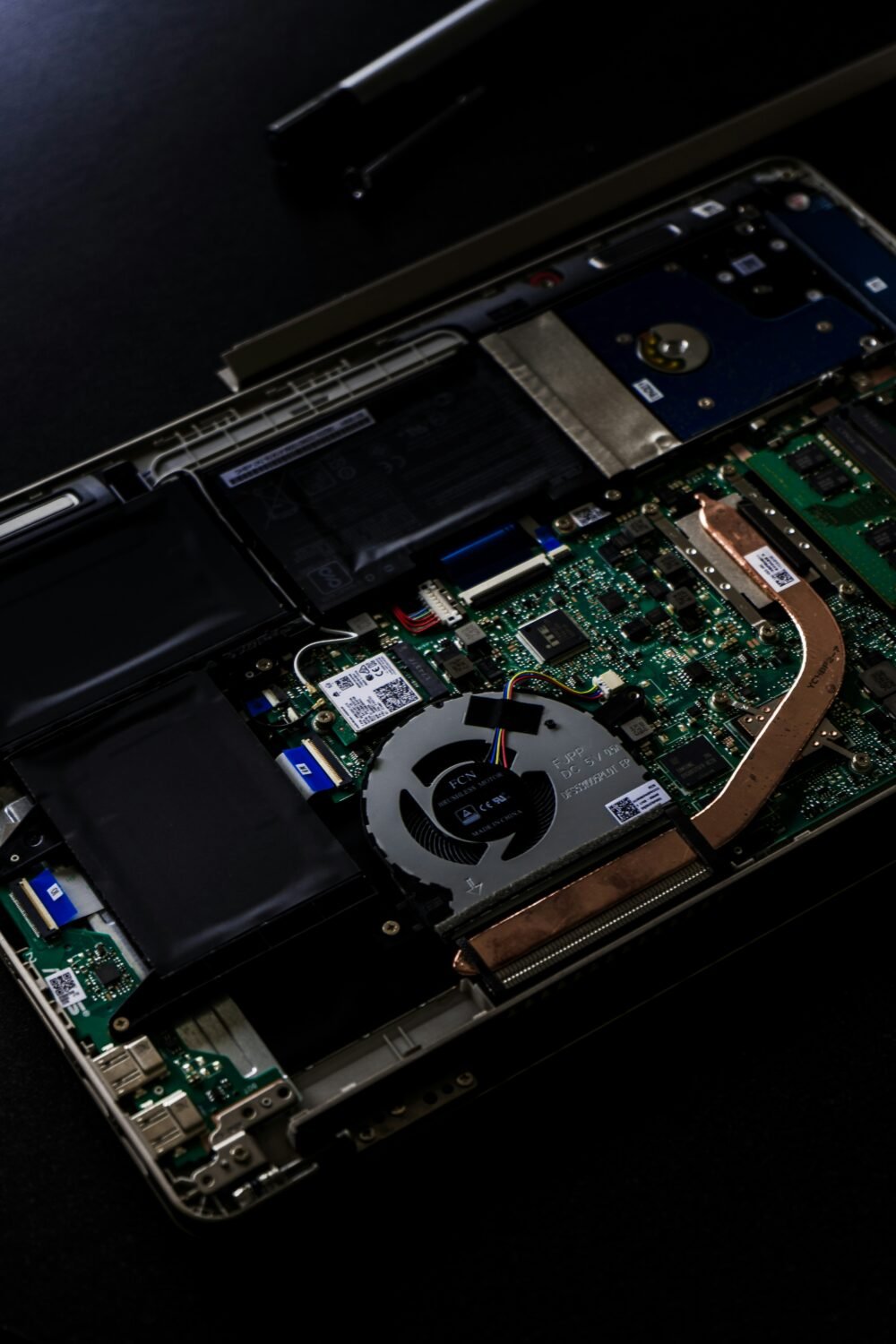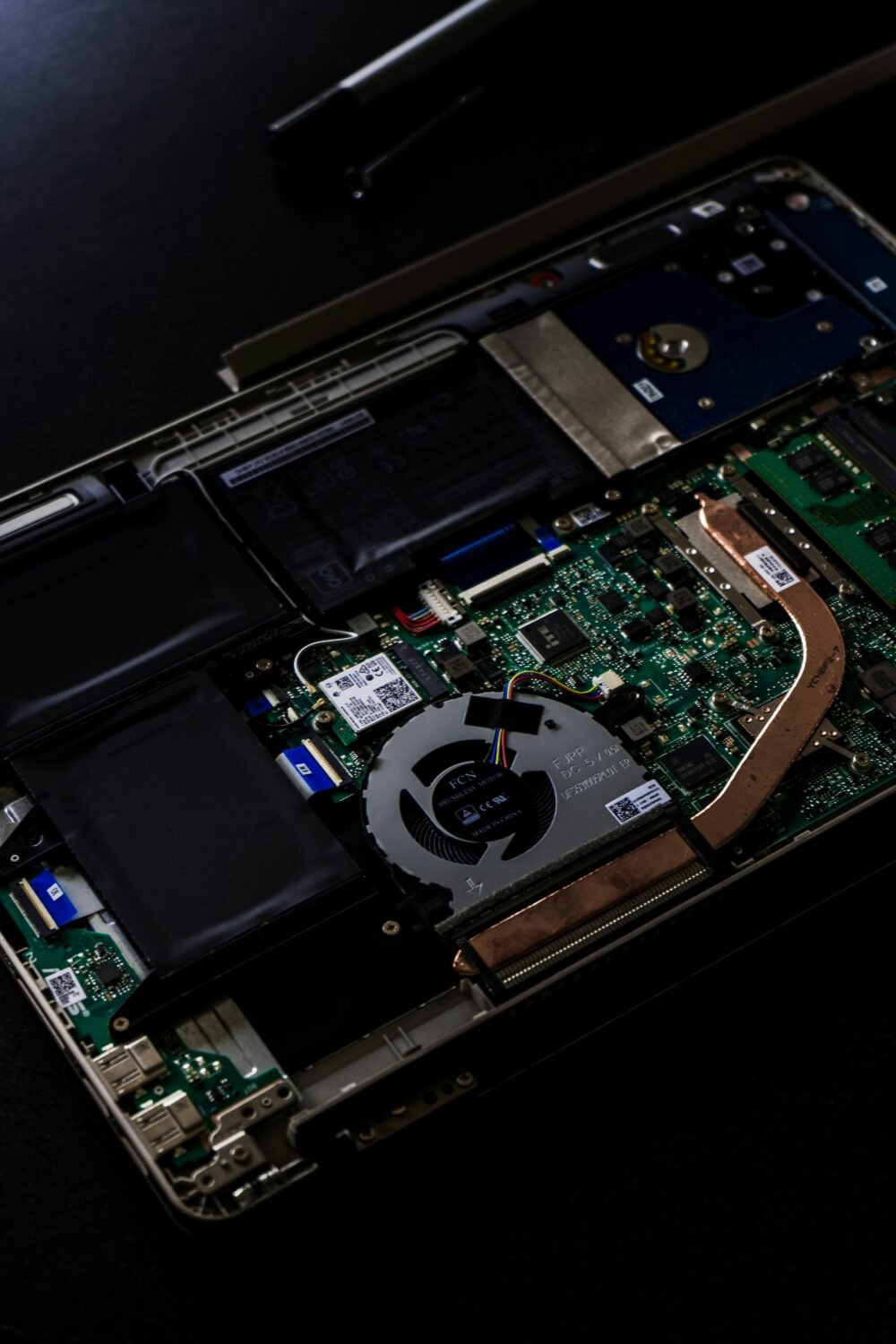list of common laptop parts with brief descriptions for each:
1. Display Screen
- Description: The display screen, or laptop monitor, is the part that shows the visual output of the laptop. It typically comes in various sizes (13-inch, 15-inch, 17-inch) and resolutions (HD, Full HD, 4K). It’s usually an LED or LCD panel.
2. Keyboard
- Description: The keyboard is the set of keys used to input text and commands into the laptop. It typically includes alphabetic keys, number keys, and function keys (F1-F12), and may include a numeric keypad on larger models.
3. Touchpad/Trackpad
- Description: The touchpad (also called a trackpad) serves as a pointing device, allowing users to move the cursor on the screen and interact with the laptop without using a mouse. It’s typically a flat, sensitive surface.
4. CPU (Central Processing Unit)
- Description: The CPU, often referred to as the “brain” of the laptop, processes instructions from programs and manages tasks. Common CPUs for laptops include Intel and AMD processors.
5. RAM (Random Access Memory)
- Description: RAM is the short-term memory of the laptop. It temporarily stores data that is actively being used by the CPU, allowing for faster access. More RAM typically allows for smoother multitasking and improved performance in heavy applications.
6. Hard Drive (HDD) or Solid-State Drive (SSD)
- Description: The hard drive or SSD stores the laptop’s long-term data, including the operating system, applications, and files. SSDs are faster, more durable, and consume less power compared to traditional HDDs.
7. Battery
- Description: The battery provides power to the laptop when it’s not plugged into an electrical outlet. Laptop batteries are typically rechargeable lithium-ion (Li-ion) or lithium polymer (Li-Po) batteries, with varying capacities affecting battery life.
8. Motherboard
- Description: The motherboard is the main circuit board inside the laptop. It connects and allows communication between the CPU, RAM, storage devices, and other components like graphics and network adapters.
9. Graphics Card (GPU)
- Description: The GPU (Graphics Processing Unit) handles rendering images, videos, and animations on the laptop’s display. Laptops may have integrated GPUs (part of the CPU) or dedicated GPUs (separate chips) for more graphics-intensive tasks like gaming or video editing.
10. Cooling Fan
- Description: The cooling fan prevents the laptop from overheating by circulating air to dissipate heat generated by internal components like the CPU and GPU. It works in conjunction with heat sinks to regulate temperature.
11. Speakers
- Description: Built-in speakers on laptops provide audio output. While they may vary in quality, some laptops feature stereo speakers or surround sound capabilities for better sound quality.
12. Webcam
- Description: The webcam allows for video capturing and live streaming. It is usually located above the display screen and is commonly used for video conferencing, video calls, and recording videos.
13. Microphone
- Description: The built-in microphone captures audio for tasks like video calls, voice commands, or recording. Some laptops have dual microphones for noise-cancellation and clearer sound.
14. Wi-Fi/Bluetooth Card
- Description: This card enables the laptop to connect wirelessly to the internet (Wi-Fi) and other devices (Bluetooth). It is typically integrated into the motherboard or installed as a separate card.
15. Ports (USB, HDMI, Audio Jack, etc.)
- Description: Laptops have various ports for connecting external devices such as USB flash drives, printers, headphones, monitors, and more. Common ports include USB (Type-A, Type-C), HDMI, audio jacks, and Ethernet ports.
16. Power Adapter
- Description: The power adapter (or charger) supplies power to the laptop from an electrical outlet. It converts AC (alternating current) power into DC (direct current) power for the laptop’s battery and internal components.
17. Optical Drive (CD/DVD/Blu-ray Drive)
- Description: Some laptops have an optical drive that reads and writes CDs, DVDs, or Blu-ray discs. This part is becoming less common in newer laptops due to the rise of digital downloads and cloud storage.
18. Power Button
- Description: The power button is used to turn the laptop on and off. It may also serve other functions like entering sleep mode or waking the laptop from standby, depending on the laptop’s settings.
19. SIM Card Slot
- Description: Some laptops, particularly those with mobile connectivity (4G/5G), have a SIM card slot that allows the device to connect to cellular networks.
20. Chassis (Body)
- Description: The chassis is the external casing or body of the laptop. It houses all the internal components and provides structural support. Laptops may have plastic, aluminum, or magnesium alloy chassis, depending on the model.
21. Heat Sink
- Description: The heat sink is a metal component that absorbs and dissipates heat from the CPU and GPU, helping prevent the laptop from overheating.
22. LED Indicators
- Description: LED lights on the laptop indicate various statuses, such as power on/off, battery charging, Wi-Fi connection, or hard drive activity.
23. SD Card Slot
- Description: Some laptops come with an SD card slot that allows users to insert SD or microSD cards for additional storage or data transfer.
24. Fingerprint Scanner
- Description: Some laptops feature a fingerprint scanner for biometric authentication, allowing users to unlock their laptop or access certain applications securely with their fingerprint.
25. Docking Port
- Description: A docking port allows you to connect your laptop to a docking station, expanding the laptop’s connectivity options, such as additional USB ports, monitors, and network connections.







